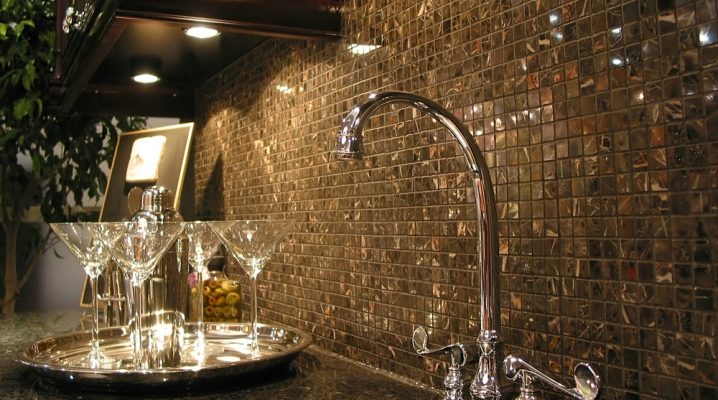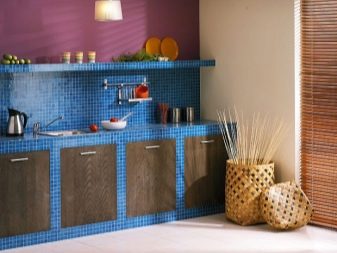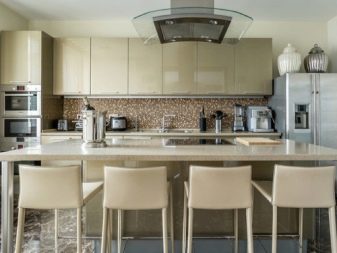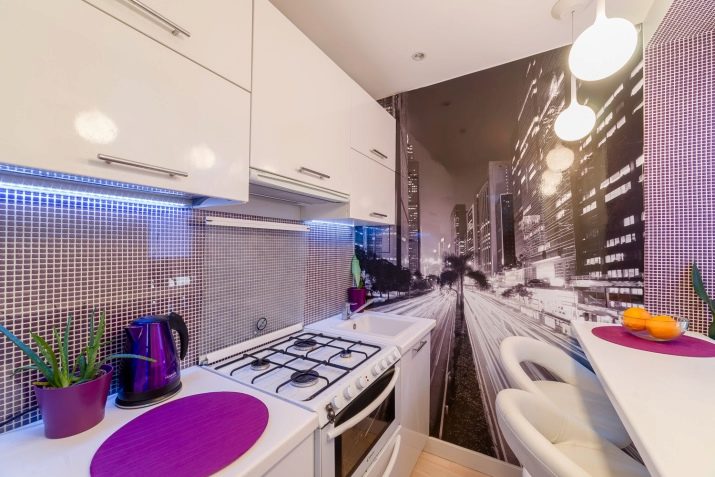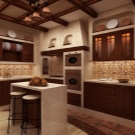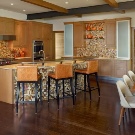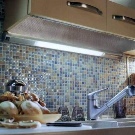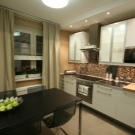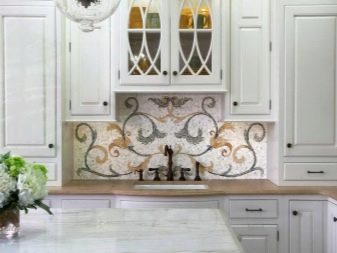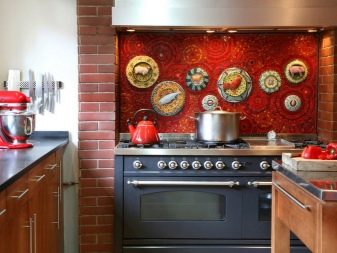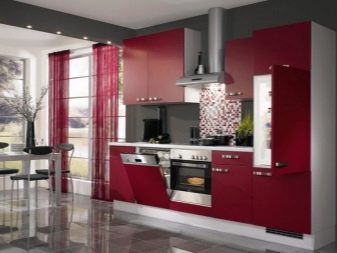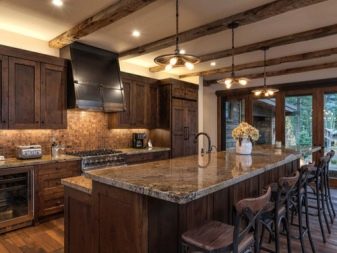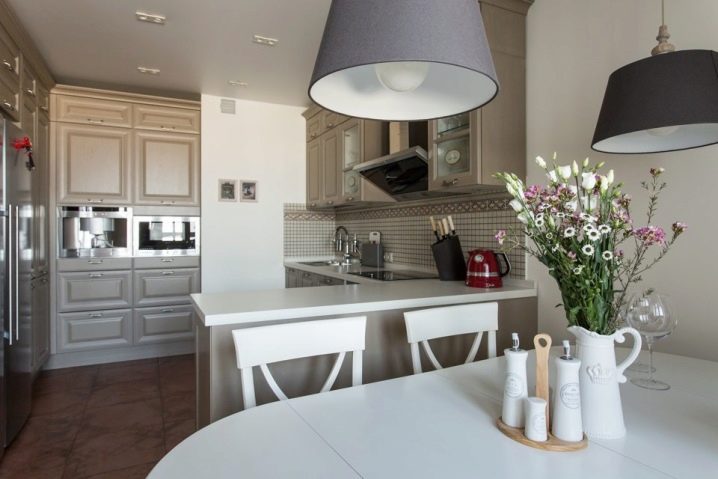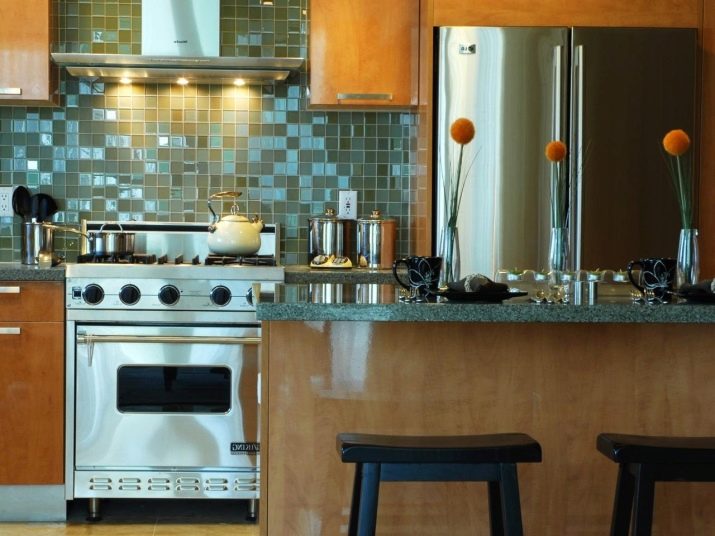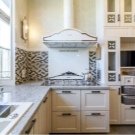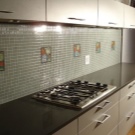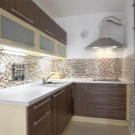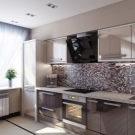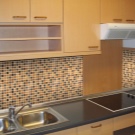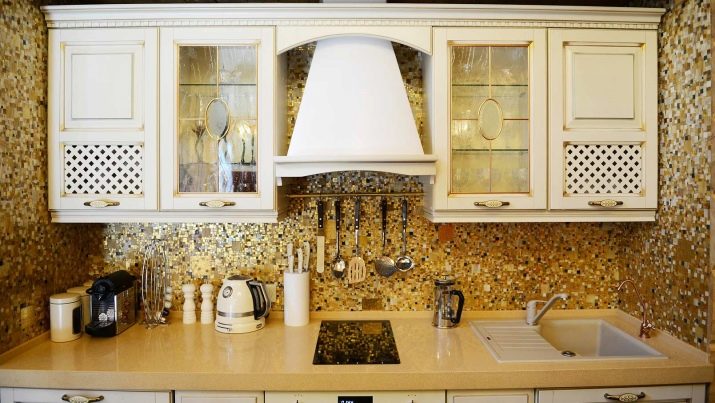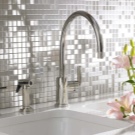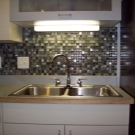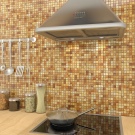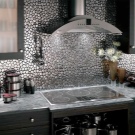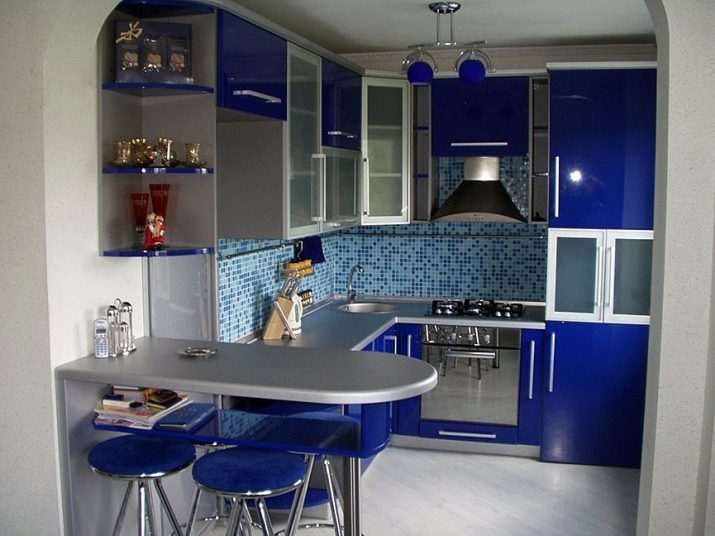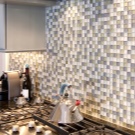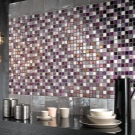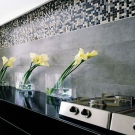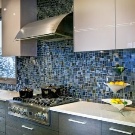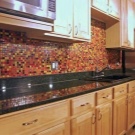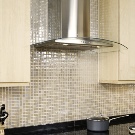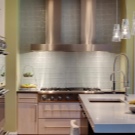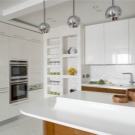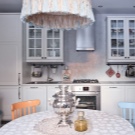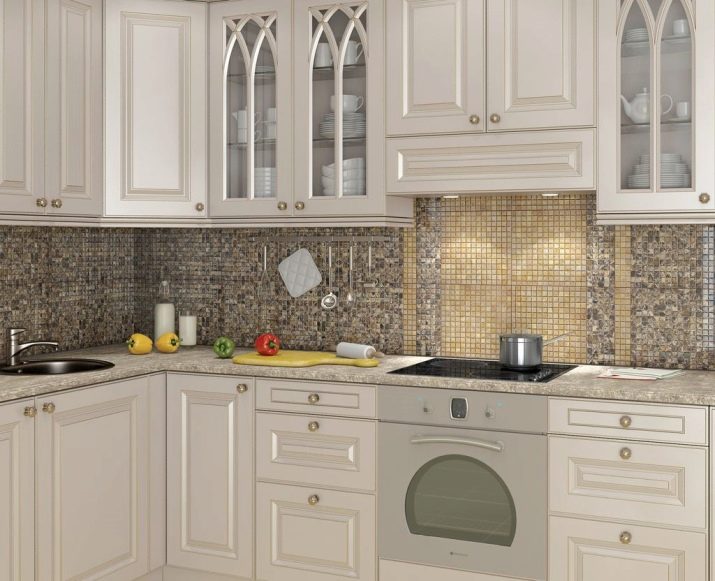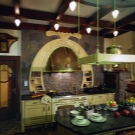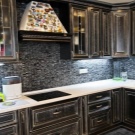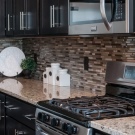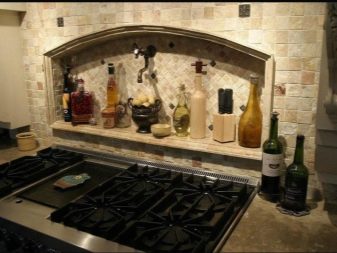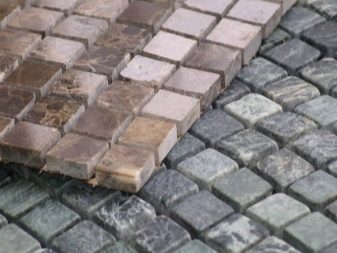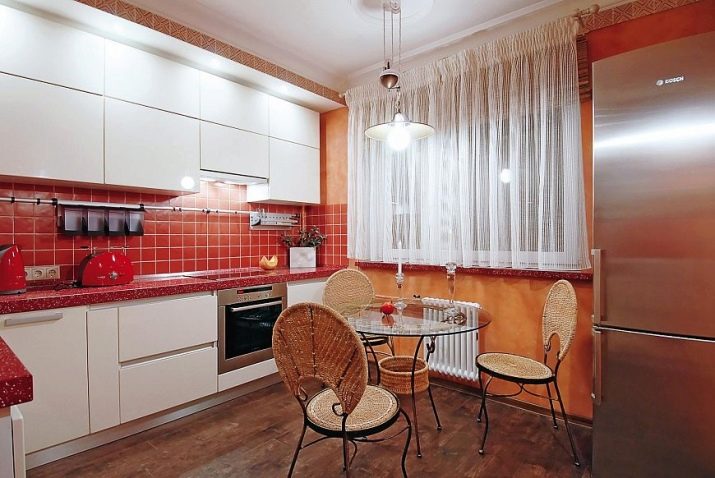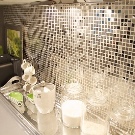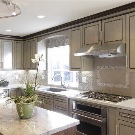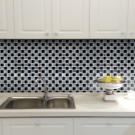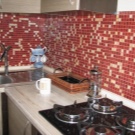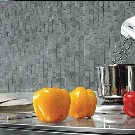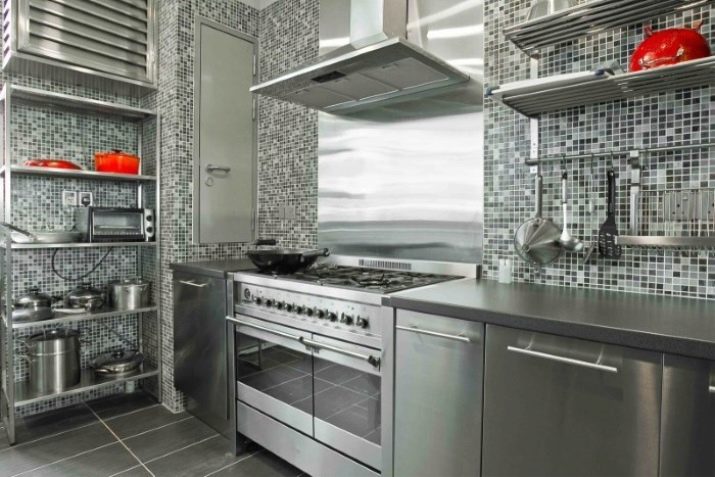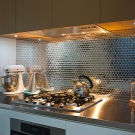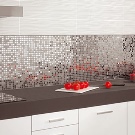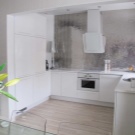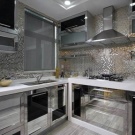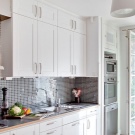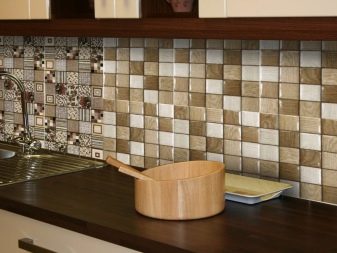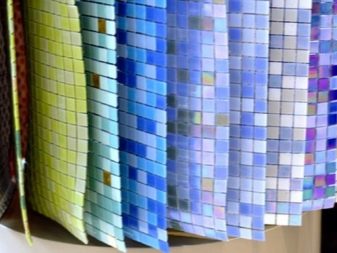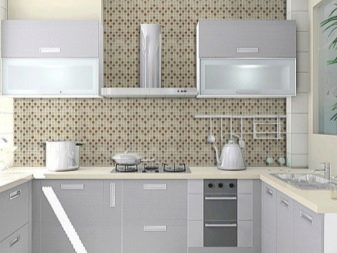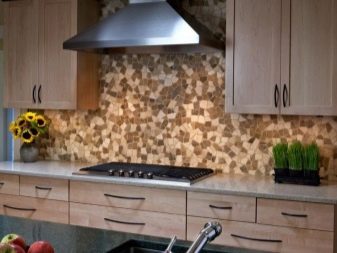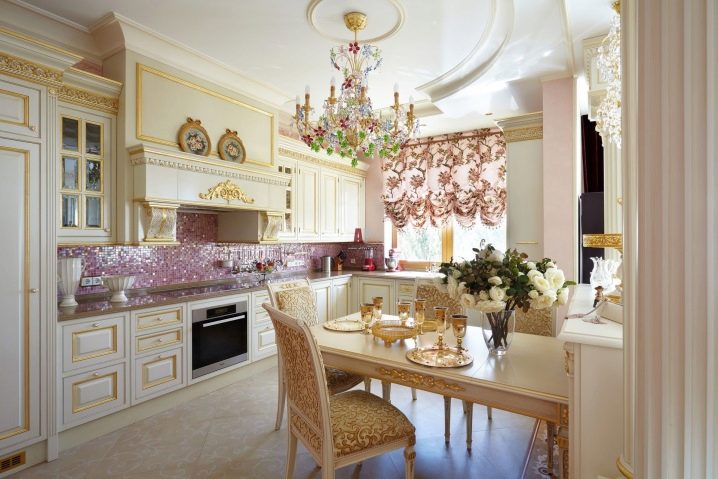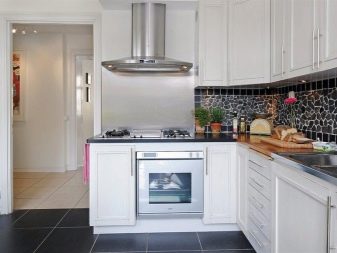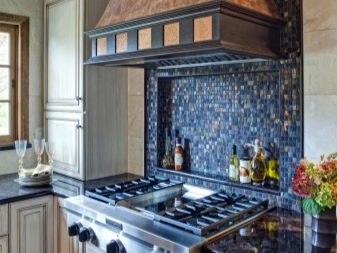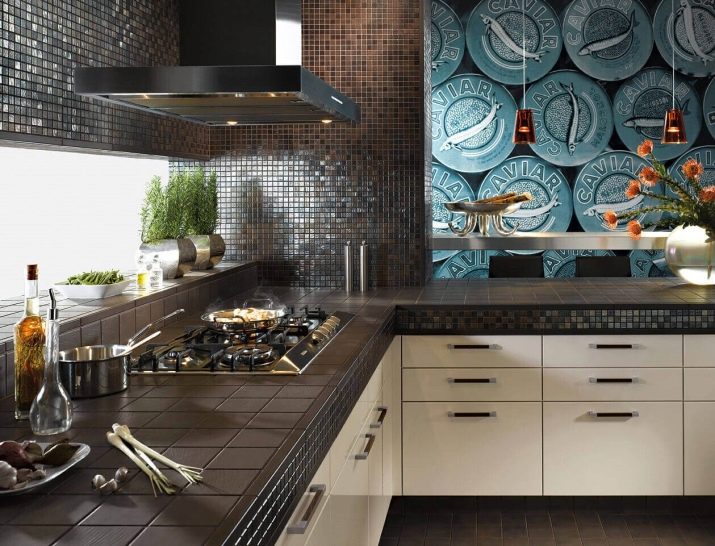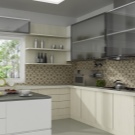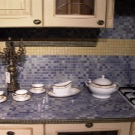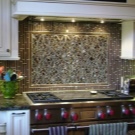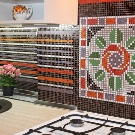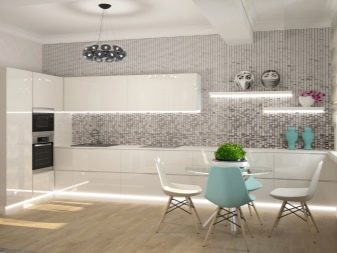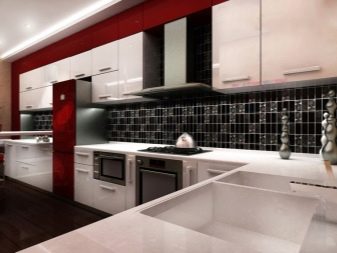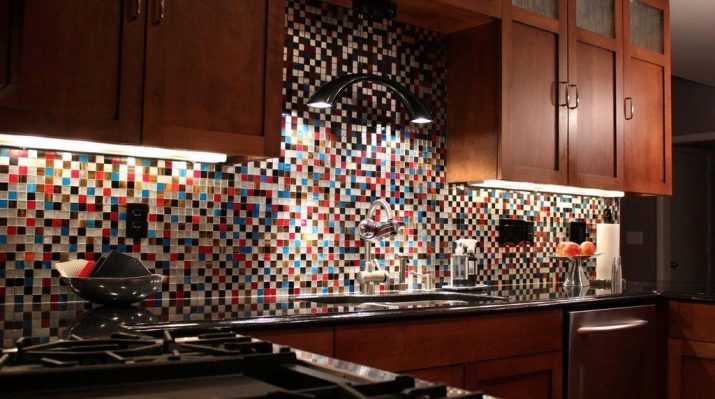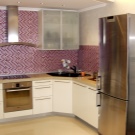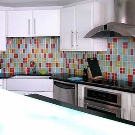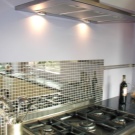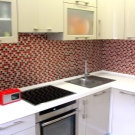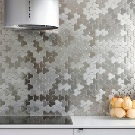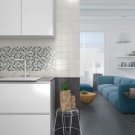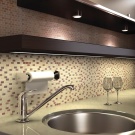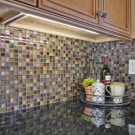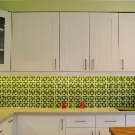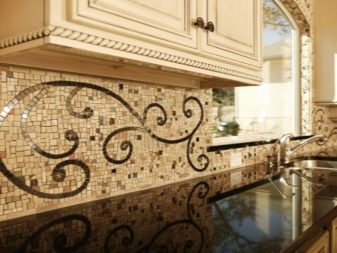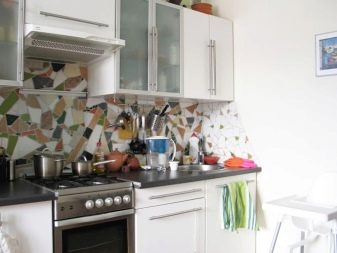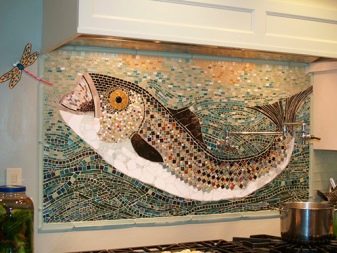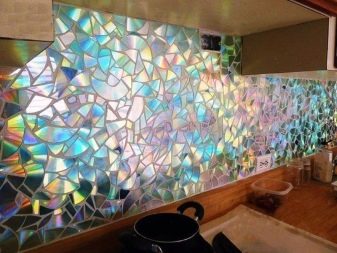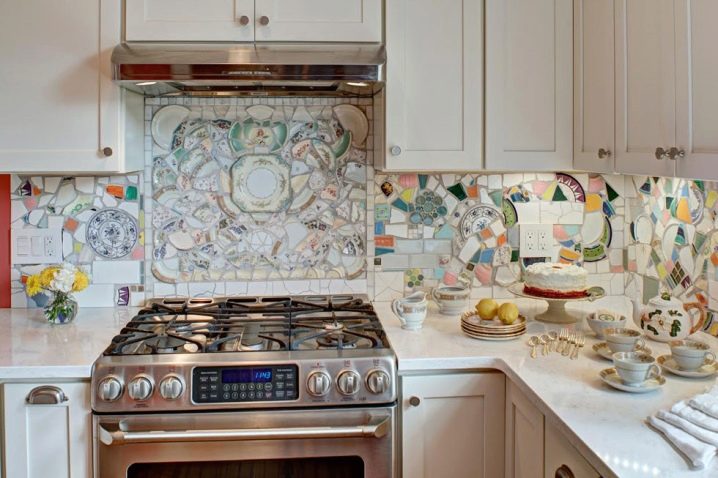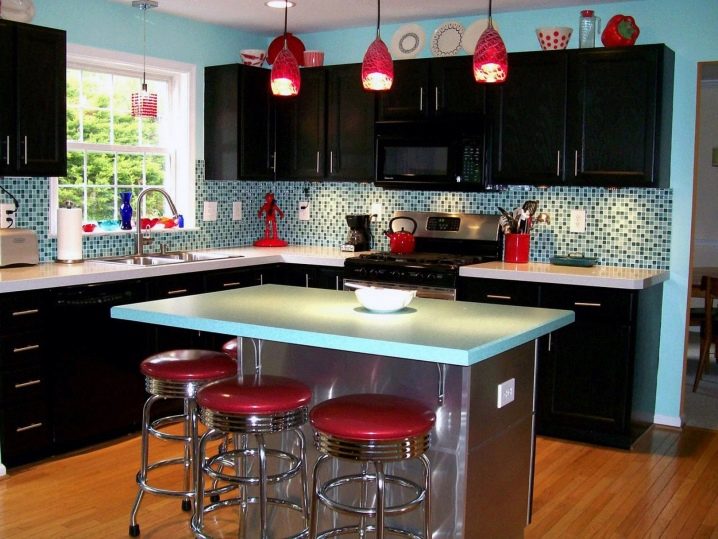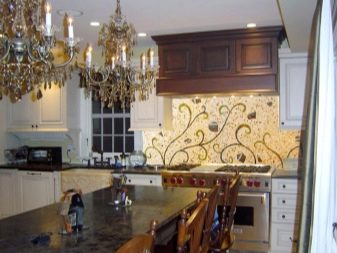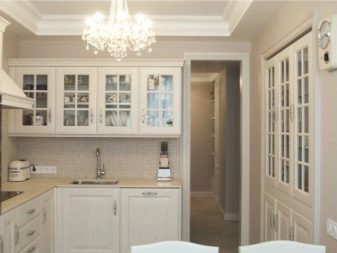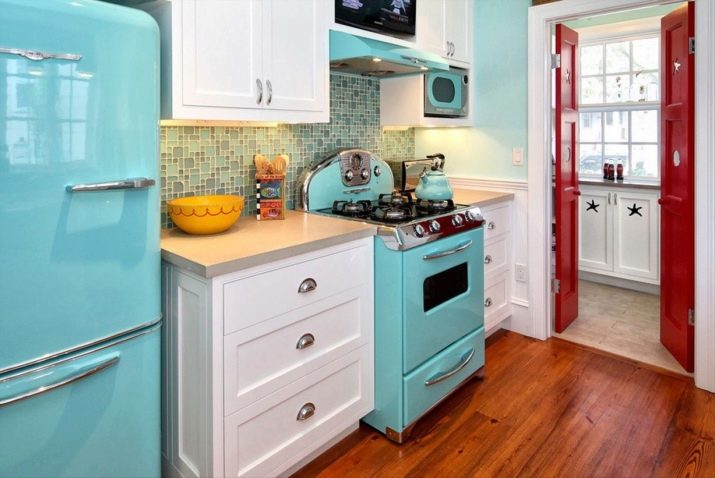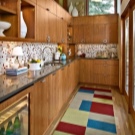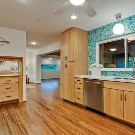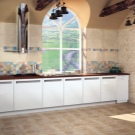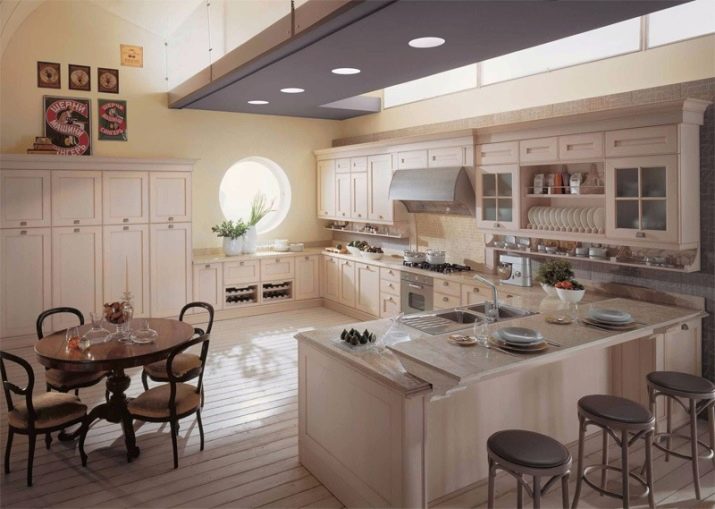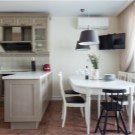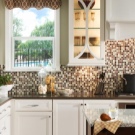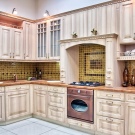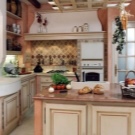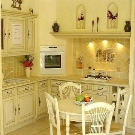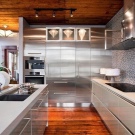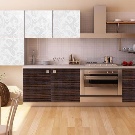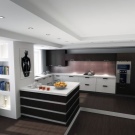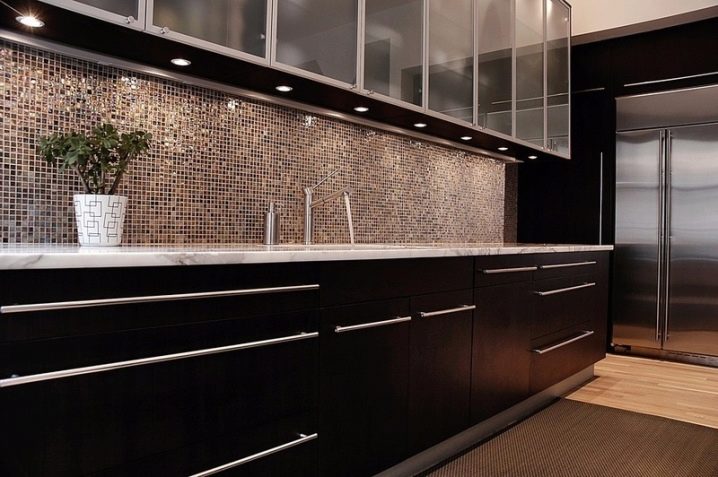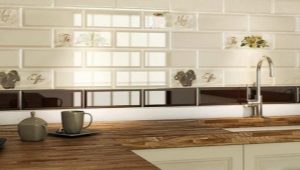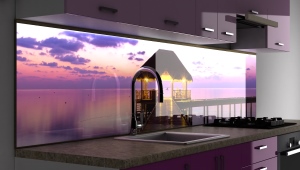Mosaic on the apron in the kitchen
Many peoples of antiquity used mosaic to decorate their palaces and temples. For example, the step pyramid of Pharaoh Djoser, built in Ancient Egypt about 2600 BC. e., decorated with colorful mosaic tiles. Later, ceramic tiles were made in almost every major European country. Today, the production of mosaic tiles is fully automated and it allows you to produce it in a huge variety of color and texture combinations.
Features and benefits
Kitchen apron from the mosaic can be a real decoration for the kitchen. The fragments that make up the mosaic canvas are more expressive than ordinary tiles, which is why it can be chosen for almost any design, from “country” to “techno”. This possibility is achieved due to the fact that in the manufacture of mosaics can be used a variety of materials, from natural stone to mother of pearl.
Color mixes, the abundance of which can be found in the mosaic, allow you to combine all the shades presented in the kitchen. At the same time, it produces a very hard and heat-resistant cloth for a kitchen apron, as a result, the working wall area is fully protected and there are practically no minor scratches or scuffs on it.
Materials
People in ancient times used mosaic paintings to decorate walls and create glass stained glass windows. Examples of this can be seen in Greek basilicas or in the Gothic temples of medieval Europe. In those days, the choice of material was not too large, plates for mosaic were created from ceramics or glass, depending on the need.
Currently, the range of materials to create this amazing decor has expanded significantly. On sale you can find a mosaic of ordinary or sea glass, plastic with a metallic coating, mirror mosaic, a classic version of a mosaic of stone or ceramics. Modern mosaic tiles are presented in various forms: in the form of rectangles, squares and even circles. The buyer can complete them to your taste, creating unique and memorable variations.
Tiled mosaic consists of molded ceramic tiles, so it resembles tile according to a set of properties - it is the same durability, resistance to high temperatures, grease and moisture, variety in decoration and versatility.
But ceramic mosaic looks more colorful and elegant in comparison with ordinary tiles. It gives the impression of a unique handmade, in addition, small mosaic tiles more successfully fit into the interior. Cons: the cost of a mosaic is almost twice the cost of a regular tile and working with it requires a larger amount of material for grouting.
There is a special type of ceramic mosaic, which is covered with a thick layer of glass. At the same time, it loses in variability of design and color, but wins in texture, since in this case the composition can be matte, glossy, rough, with the effect of antiquity, or with imitation of a stone. The thickness of the material covered with glass is twice the size of ordinary ceramics and is 8-10 mm.
The most popular of all types of mosaic tiles for decorating an apron in the kitchen is wall tiles made of glass.This is due to the fact that it is easy to clean, very durable, looks attractive and has the most reasonable price. Glass mosaic tiles are much stronger than ordinary glass, despite the same composition of components. This is due to the high firing temperature and the small size of its components.
Mosaic glass can be divided into several types:
- Homogeneous glass, which is also called Venetian glass. These are small glass blocks that can be shiny and multi-colored, like candy; or as stupid as stones turned by the sea. In addition, foil, glitter and other small materials can be added to glass;
- Smalt. This is a baked mixture of pressed glass. It is colored with metal oxides, such as cobalt, copper, chromium, uranium, nickel, iron and silver. Golden smalt, which was incredibly popular in the Byzantine era, was made using thin sheets of gold leaf.
Smalt has a very high strength (due to what it can be placed even on the floor), and rich colors, an unusual effect that resembles an internal glow, since each tile of smalt glass is somewhat different from the next.Smalt may have a different appearance depending on additives and coatings, for example, it is similar to mother of pearl;
- Glass tile, supplemented with mineral composition. To make a mosaic tile that looks like precious stones, molten glass is mixed with minerals such as quartz, iridium, or even aventurine semi-precious stone. Such a mosaic has a high price, but it looks simply luxurious, with a brilliant iridescent surface and a complex mixed color.
- Pearl mosaic can be considered a variety of glass mosaic. Nacre is one of the most beautiful decorative materials, possessing also unique and unusual properties: reflecting and muffling the light directed at it, it disperses it and makes it softer. Nacre, moreover, has the property to shimmer with all the colors of the rainbow. Obviously, such a pearl mosaic will be very, very expensive, but you can always save money by choosing a glass mosaic with a mother-of-pearl coating.
- The classical stone mosaic is another version of the design of the kitchen apron. It belongs to the category of elite and expensive materials.For its production uses a variety of stones and minerals, from marble to jasper or onyx. The stone is a very durable material, besides, every natural stone is unique and unique. Since the stone is a porous material, in order to preserve its beauty longer, it is treated with a special protective composition, filling the pores. Such processing will greatly facilitate the care of a mosaic apron made of stone.
Stone mosaic varies in manufacturing technology:
- Roman technologywhich distinguishes the use of marble;
- Florentine technology manufacturing allows mixing of materials;
- Russian technology It is based on the fact that a plate of simple material is pasted over with expensive varieties of stone.
An excellent alternative to stone can be a mosaic of porcelain stoneware, as it is as durable as a stone, but more affordable and less porous. Porcelain tile surpasses ceramic tiles in strength, but is inferior to it in the variability of design. Artificial stone has less brightness and brilliance, and, as a rule, has a neutral color palette, including shades from beige to dark brown.In addition, porcelain tile is different manufacturing process. Porcelain tile is cut, and not poured into molds, like ceramic tiles, therefore it has a rough edge.
- Metal mosaic It is usually made of ceramic, rubber or plastic, having the appearance of steel or metals of golden hues. This is achieved by covering the base material with a layer of metal. An apron made of metal mosaic is practical and safe, but, unfortunately, the metal decorative cover itself is short-lived.
The mosaic consists of pieces of a mirror having a thickness of 5 mm. It is quite durable, but requires more thorough care. Fragments of a mirror are often made in the form of square or rectangular pieces. They may have the usual mirror shine, but there is also a tinted mirror mosaic.
Kinds
In ancient times, mosaics were assembled from small pieces, which required the master to have great patience, perseverance and artistic taste. Modern mosaic, as a rule, is not sold as a placer, it has the appearance of square plates from already selected small fragments. Such plates are called matrices; they can be from 24 cm × 24 to 32 × 32 cm. Usually for covering an area of 1 sq. M. Meter enough 9 plates - matrices.
The fragments that make up the mosaic pattern itself are called “chip” or “tesser”. Chip size may also vary. There are 1x1 cm chips, there may be larger ones, for example, 5 cm × 5 cm, the maximum chip size is 10 × 10 cm.
Most of the matrices have the shape of squares, as it is convenient when laying, makes it easier to cope with the calculations of the necessary material and fits comfortably into any interior. Rectangular plates are also very popular. Hexagons, rhombuses, circles and triangles are much less common, but, if desired, such options can be found on the market.
Typically, the chips are glued to the polyurethane mesh, located on the back of the matrix.
Another option is to mount on a paper basis. In this case, the paper is glued to the front of the tile, and must be removed before grouting.
The most convenient and reliable option is mounting on the grid. At the same time, the matrix does not break and is easier to glue. It is very important that in this case the grid also performs the reinforcement function.
Color solutions
Through the use of mosaics of different colors, you can achieve interesting visual effects in the kitchen. For example, smooth corners by using color stretching, or expand the room visually. By manipulating a mosaic finish, for example, by decorating an unfortunate acute angle in a room, you can turn it into an elegant element of the interior.
Mosaic images can be divided by color options. These will be:
- Monochrome, or monocolor imageswhich in turn may be glossy, matte or embossed;
- Mixed colorswhich can be either contrasting tones or related shades;
- Gradient imageswhich differ in transition of shades of one color saturated in the center and weakened to the edges;
- Pictures - panels, made either from factory components, or manually by a master - artist.
How to choose
The most popular variants of mosaic lining of the kitchen apron are, of course, glass and ceramic mosaic. In these categories there are many varieties and species that are worth paying attention to.
Manufacturers belonging to numerous brands offer collections of mosaic canvases already selected in a certain color range. Some of them may include exclusive expensive panels, which, undoubtedly, will give individuality to the kitchen interior.
There is an unspoken rule according to which, the brighter and more diverse the color shades of the mosaic tile, the higher its value. This is due to the complexity and cost of production. The most inexpensive are monocolors. Further, at a cost, there are white mixes with gray, beige and brown tones, not complicated by the presence of decorative additives.
In the event that the color palette of a mosaic is multicolored, with complex decoration elements, its price will be much higher. In this case, it is worth considering the option of using a brighter and more impressive fragment as an insert into a simple mosaic canvas in order to save the budget.
The most famous are the mosaic compositions of the famous Italian factory Bisazza and the Chinese factory Irida. In Russia, Kerama Marazzi tile is popular, which, at fairly reasonable prices, offers decent product quality.The best-known manufacturers of metal mosaics are Italian firms L, Antic and Madreperia Mosaico, as well as the Chinese company Bertini, which owns the development of a collection of metallized mosaic tiles called Metal Mosaico.
It is important to remember when choosing expensive and complex mosaic variants, that they should be purchased only from trusted vendors in order to avoid artisanal fakes that do not have the proper quality.
How to do it yourself
In the event that an exclusive mosaic composition is desirable for decorating a kitchen apron, it can be made with your own hands.
To start work, it is necessary to measure the area of the apron, in order to assess how much material needs to be purchased. To do this, attach several sheets of paper in such a way as to close the entire surface. The size of the sheets will be equal to the required area.
Acquired lining material must be broken into small pieces, of which the mosaic will be made. In the process of breaking a solid tile, you can use any available material: a hammer, or durable scissors.
Among the materials used may be ceramics, glass, broken porcelain, etc. It is worth using the creative potential to the maximum, but first of all, you need to make sure that the chosen colors are well combined with the shades of the rest of the kitchen.
The next step is to place the tile fragments on the pattern that repeats the surface of the kitchen apron. They need to be laid out in the form of a pattern that you want to create on the wall.
To do this, you need to spread the paper on the floor, and lay out fragments of the pattern, not forgetting to leave small (less than 1 cm) gaps between them. In the future, this pattern will be used as a guide when applying a mosaic on the wall.
PBefore laying the mosaic, it is necessary to clean the surface of the wall from dust and dirt, and also to degrease it. For full alignment, you can apply a white putty. It is possible to glue the mosaic only after the wall is completely dry.
Glue should be selected waterproof, in addition, it must have anti-fungal properties. You need to start sticking from the very central fragment of the pattern.
Using tile adhesive, you need to stick the first piece in the center of the apron. Then each fragment carefully and carefully put on the place reserved for him.Work in this case is carried out from the center down, and then from the center to the top. When laying it is necessary to maintain the distance between the pieces of the mosaic.
Glue is allowed to dry completely for at least 24 hours, and then proceed to grouting. To do this, prepare the trowel mixture in accordance with the manufacturer's instructions and distribute it over the surface of the pattern with a rubber spatula.
After about 15 minutes, wipe off stains and excess grout with a damp sponge.
Interesting options in interior design
In order for the mosaic tile to look in the most spectacular light and adorn the kitchen interior as much as possible, it should be used in strict accordance with the chosen style.
For example, the choice of a mosaic for a classic kitchen, or a techno-style kitchen will be noticeably different.
White classic kitchen, consisting of furniture of strict forms without any decorative excesses, allows for the presence of a bright mosaic apron. Such an apron should combine all the design elements with its color palette: walls, floor, cabinets, kitchen utensils and lighting fixtures. You can choose a simple mix of shades, a gradient image or a panel. A beautiful picture made of ceramic or glass mosaic becomes in this version of the interior the main decoration and source of good mood for owners of such a kitchen.
Kitchen in the style of "retro" implies the presence of vintage furniture and kitchen appliances. Coloring cabinets in such a kitchen can be worn, with the effect of patina, to create the desired impression. The handles of wall cabinets, the fridge and the stove should have a brilliant steel shade, and the chandeliers should be simple and functional. For a kitchen apron in this style is suitable ceramic mosaic. The mix of shades will combine color of a floor, kitchen set and walls and will create impression of a complete composition.
The Italian-style or Provence-style kitchen is notable for its homely simplicity and artlessness. In such a kitchen there is no place for plastic and an abundance of glass facades, here there are soft pastel colors and a lot of natural color of wood and leather. TA large table, traditional for Italian cuisine, located in the center is the main decoration of such a kitchen.
A kitchen apron in this design performs an exclusively utilitarian function, therefore it should blend in color with the furniture of the headset or the walls. Small ceramic mosaic can unobtrusively emphasize the general mood of the room and visually enlarge its size with its soft brilliance. Mosaic fragments in contrast to the classic large tiles will convey the refinement of this style.
The techno-style kitchen can be decorated with an apron made of shiny metal mosaic. It is the brilliance of the metal kitchen apron that will create a modern and dynamic mood throughout the room. Mosaic can be steel, bronze or aluminum color. It is under her shade that the handles of kitchen cabinets, the faucet, the sink, and the hood are selected. In this style, the mosaic sheet solo, emphasizing the simplicity of dark wood furniture and light walls.
Another use of modern mosaic is a glass mosaic of chocolate or caramel tones. Small flickering elements of such a mosaic dilute the strict and cold atmosphere created by practical modular cabinets. The choice of colors of furniture in the modern kitchen due to considerations of utility, so they are boring to the eye. It is the shimmering and iridescent kitchen apron of glass mosaic that can revive such an interior and give it attractive mystery.
The use of mosaic canvas for the design of a kitchen apron in various design options gives a highlight to the interior, attracting views and creating a positive mood.
